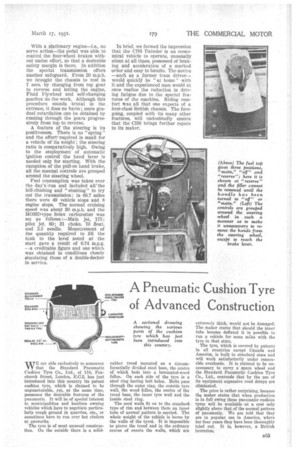A Pneumatic Cushion Tyre of Advanced Construction
Page 123

If you've noticed an error in this article please click here to report it so we can fix it.
WE are able exclusively to announce that the Standard Pneumatic Cushion Tyre Co., Ltd., of 110, Fenchurch Street, London, B.C.% has just introduced into this country its patent cushion tyre which is claimed to be unpuncturable, yet, at the same time, possesses the desirable features of the pneumatic. It will be of special interest to municipalities and hauliers owning vehicles which have to negotiate particularly rough ground in quarries, etc., or sometimes have to run over hot cinders at gasworks.
The tyre is of most unusual construction. On the outside there is a solid rubber tread mounted on a circumferentially divided steel base, the centre of which beds into a laminated-wood felloe. On each side of the tyre is a steel ring having bolt holes. Bolts pass through the outer ring, the outside tyre wall, the wood felloe, the centre of the tread base, the inner tyre wall and the inside steel ring.
The cord walls fit on to the standard type of rim and between them an inner tube of normal pattern is carried. The whole weight of the vehicle is borne by the walls of the tyres. It is impossible to pierce the tread and in the ordinary course of events the walls, which are
extremely thick, would not be damaged. The maker states that should the inner tube become deflated it is possible to run a vehicle• for some miles with the tyre in that state.
The tyre, which is covered by patents in all countries except Canada and America, is built in standard sizes and will work satisfactorily under reasonable overloads. It is claimed to be unnecessary to carry a spare wheel and the Standard Pneumatic Cushion Tyre Co., Ltd., contends that by the use of its equipment expensive road delays are eliminated.
The price is rather surprising, because the maker states that when production is in full swing these pneumatic cushion tyres will be available at a cost only slightly above that of the normal pattern of pneumatic. We are told that they are in popular use in America, where for four years they have been thoroughly tried out. It is, however, a British invention.
























































































































































































